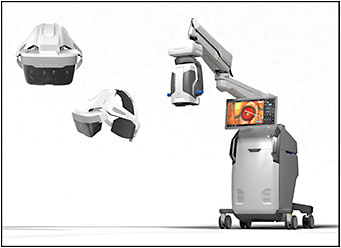Beyeonics One is the first ophthalmic exoscope to feature an augmented reality surgical headset. The exoscope, a high-definition, fully digital imaging platform, enables surgeons to see a magnified 3-dimensional image of the surgical field, says Aimee Shimamoto, director of marketing for BVI, Americas division. BVI has established a commercial partnership with Beyeonics Vision to bring Beyeonics One to ophthalmic surgeons in the United States. The platform is designed to deliver enhanced visualization and on-demand consolidated preoperative information, all of which are accessible and controlled by an immersive augmented reality surgical headset.
“The goal of the ophthalmic exoscope is to reimagine the whole microsurgical experience from the surgeon’s perspective,” says Jorge I. Calzada, MD, CEO and founder of Deep Blue Retina in Southaven, Mississippi, who is also a consultant for and early adopter of Beyeonics One. The device replaces standard optical magnification systems with digital imaging. The headset allows for novel control of an image with gyroscope-based head gestures; for rapid and exact zooming, panning, and focusing; and for advanced control of image characteristics. The platform and AR surgical headset were inspired by pilots’ head control units.
“Pilots and physicians have a lot of similarities in their working environments; they both need superior visualization, control over their operating field, and real-time data to make critical decisions,” says Efi Zaritzky, vice president of global marketing at Beyeonics Vision. “Beyeonics One translates the vision of a pilot’s cockpit into an immersive operating experience for surgeons.”

FEATURES AND BENEFITS
The transition from optical to digital surgical microscopy is here, with multiple companies pursuing similar strategies, Dr. Calzada says. Ultimately, the goal is to increase the amount and quality of real-time data that is presented to surgeons in a seamless fashion, increase the signal-to-noise ratio of surgical data, and improve surgical outcomes and surgical efficiency. What sets the Beyeonics system apart is its augmented reality headset.
“Most companies are pursuing screen-based platforms coupled with 3D glasses [but] Beyeonics One’s headset system improves operating room space utilization and increases surgeon ergonomics and control,” says Dr. Calzada.
Shimamoto points out that Beyeonics One provides a highly magnified, detailed image of the surgical field through its fully digital optic design. The augmented reality surgical headset allows surgeons the freedom to move and adopt their most natural positions without losing the surgical view. It also lends itself to unconstrained workflow efficiency. “There is zero perceived latency through intuitive head gesture controls; a surgeon can maintain a continuous view of the surgical view without losing hand-eye coordination,” Shimamoto says.
The all-in-one fixed operating room setup requires no additional turnover time to reconfigure an operating room when switching from right eye surgery to left eye surgery, Shimamoto says. Furthermore, the open platform approach will enable future integration with operating room systems, such as electronic medical records systems, picture archiving, and communication systems, as well as remote connectivity for service and upgrades, Zaritzky says.
Beyeonics One is suitable for all ophthalmic procedures, including retina, cataract, glaucoma, and corneal surgeries. Beyeonics One also offers benefits in an educational setting. A learner can share the same immersive view of the surgical field as the primary surgeon or sit in a 90° angle, enabling them to observe or assist. “A simultaneous view of the surgical field allows for a meaningful teaching and learning experience, whether remote or live,” Shimamoto says.
A FOCUS ON ERGONOMICS
A significant benefit to using an augmented reality headset is comfort. Many ophthalmic surgeons said they have musculoskeletal pain. In a recent study, 81.4% of ophthalmologists reported musculoskeletal pain or discomfort.1 In a study of 64 US ophthalmic surgeons, 82% reported less pain or discomfort during surgery with heads-up technology and 69% preferred heads-up technology to a microscope.2
“Beyeonics One is the only visualization platform that allows surgeons to adopt a natural posture while operating for long hours,” says Shimamoto.
Says Dr. Calzada, “The Beyeonics headset completely removes any form of tethering to the microscope. The headset doesn’t have any significant perceived weight; I don’t have any noticeable neck strain after a long day of continuous use. This creates ergonomic freedom.”
As a tall surgeon, Dr. Calzada has always struggled with lower back pain. “The improved ergonomics allows me to finish a long day in the operating room with minimal wear and tear on my body,” he says.
LOOKING AHEAD
Digital microscopy has finally matched optical microscopy for standard surgical procedures. “Whereas optical microscopy is an excellent and time-proven method, it just can’t be improved upon any further,” Dr. Calzada says. “We have reached a plateau imposed by physics when dealing with optical systems.”
On the other hand, digital systems can improve orders of magnitudes beyond current capacities. “We can predict improvements in real-time image processing, coupled with innovative comingling image presentation to surgeons,” Dr. Calzada says. “The incorporation of preoperative imaging and intraoperative optical coherence tomography information overlays into the surgical field will be realized in the near future.”
Dr. Calzada also believes that it’s possible for visualization through media opacities to be achieved in the coming years. “The future of regenerative medicine may require novel tangential or microendoscopic visualization to enter the subretinal space in ways we can barely dream of,” he concludes. RP
REFERENCES
- Tan NE, Wortz BT, Rosenberg ED, Radcliffe NM, Gupta PK. Digital survey assessment of factors associated with musculoskeletal complaints among US ophthalmologists. Clin Ophthalmol. 2021;15:4865-4874. doi:10.2147/OPTH.S341516
- Weinstock RJ, Ainslie-Garcia MH, Ferko NC, et al. Comparative assessment of ergonomic experience with heads-up display and conventional surgical microscope in the operating room. Clin Ophthalmol. 2021;15:347-356. doi:10.2147/OPTH.S292152








